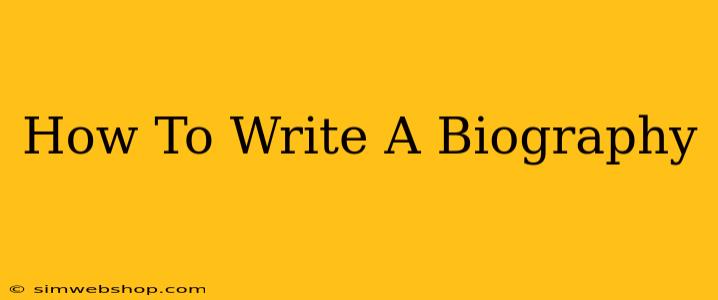Writing a compelling biography is more than just listing a person's life events; it's about weaving a narrative that reveals their character, motivations, and impact on the world. Whether you're crafting a biography of a famous figure or a loved one, this guide will equip you with the essential steps to create a captivating and memorable read.
Understanding Your Subject: The Foundation of a Great Biography
Before putting pen to paper (or fingers to keyboard!), thorough research is paramount. This stage sets the tone and depth of your entire project.
Gather Information:
- Interviews: Conduct in-depth interviews with the subject, family members, friends, colleagues, and anyone who knew them well. Record these conversations and meticulously transcribe them.
- Documents: Explore archives, letters, diaries, journals, photographs, and any other documents that offer insights into their life. These primary sources are invaluable.
- Public Records: Utilize birth certificates, marriage licenses, obituaries, and other public records to verify facts and dates.
- Existing Biographies & Articles: Research existing biographies and articles about your subject. This provides context and helps you identify gaps in existing knowledge.
Develop a Central Theme:
What is the core message or idea you want to convey about your subject's life? What was their most significant accomplishment, struggle, or contribution? Identifying a central theme will guide your narrative and prevent your biography from becoming a disorganized list of events.
Structuring Your Biography: Creating a Narrative Arc
A compelling biography reads like a story, with a beginning, middle, and end. Structure is key to maintaining reader engagement.
Chronological Approach:
This classic approach follows the subject's life in chronological order, from birth to death. While straightforward, it's crucial to avoid monotony by highlighting key turning points and pivotal moments.
Thematic Approach:
This approach organizes the biography around specific themes or aspects of the subject's life. This can be particularly effective when focusing on a specific achievement or period in their life.
Combines Approaches:
You can often combine chronological and thematic approaches for the most engaging narrative. For example, you might use a chronological framework but highlight specific themes within each period of their life.
Writing Style and Voice: Finding Your Tone
The writing style you choose will heavily influence the reader's experience.
Maintaining Objectivity:
While expressing your admiration for your subject is acceptable, maintain objectivity in your portrayal. Present both their strengths and weaknesses honestly and fairly.
Engaging Language:
Use vivid language, descriptive details, and strong verbs to bring your subject's life to life. Avoid overly formal or academic language unless appropriate for your target audience.
Show, Don't Tell:
Instead of simply stating facts, use anecdotes and specific examples to illustrate your points. This helps the reader connect with your subject on a more personal level.
Essential Elements of a Great Biography
- Detailed Background: Include detailed information about their early life, family, education, and formative experiences.
- Key Relationships: Explore the significant relationships in your subject's life – romantic, familial, professional – and their impact on their journey.
- Challenges and Triumphs: Highlight the obstacles they overcame and the successes they achieved. This showcases resilience and character.
- Legacy and Impact: Conclude by discussing the lasting impact your subject had on the world, their field, or their community. What is their legacy?
Editing and Proofreading: Polishing Your Masterpiece
Once you've completed the first draft, rigorous editing and proofreading are essential.
- Self-editing: Review your work carefully, paying attention to grammar, spelling, punctuation, and sentence structure.
- Peer review: Ask friends or colleagues to read your biography and provide feedback. Fresh eyes can identify weaknesses you may have missed.
- Professional editing: Consider hiring a professional editor for a polished final product.
By following these steps, you can craft a biography that is both informative and engaging, capturing the essence of your subject's life and leaving a lasting impression on your readers. Remember, the best biographies are those that not only tell a story but also reveal something profound about the human experience.

